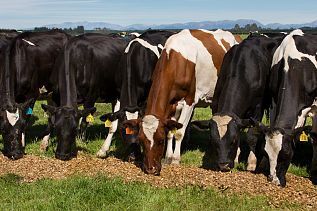
Articles
Maize silage ideal for transitioning cows off beet

Feeding fodder beet as a supplement for dry cows in the South Island has increased in popularity in recent years. However, many farmers are struggling to transition cows well from fodder beet to pasture once cows have returned from grazing.
When moving from fodder beet to pasture, cows experience a rapid dietary change from a carbohydrate-heavy diet to a fibre-rich diet.
A sudden dietary change is not recommended, particularly in the late-dry, pre-calving period. Rumen bacteria is very specific in what they digest; a diet high in carbohydrates (sugar or starch) means more carbohydrate digesters are present, while a diet high in fibre means more fibre digesters are required.
This is where maize silage is making a name for itself. Many farmers are finding it is the ideal feed for cows coming off fodder beet.
As maize silage contains a balance of carbohydrates (from the grain) and fibre (from the plant), the combination of the two allows the rumen microbes time to adjust from a carbohydrate-heavy diet to a fibre-rich diet with less stress on the rumen. Feeding maize silage in conjunction with pasture when cows return from fodder beet helps improve rumen efficiency as the cow’s rumen bugs adjust to their new diet.
Also, as good energy intake is critical throughout the season, particularly in early lactation, any feed shortage can increase condition score loss and result in an increased incidence of metabolic disease (such as ketosis), lowered production and slower cycling.
Having a stack of maize silage is proving invaluable to fill any temporary feed deficits that low spring pasture growth rates may bring.
Lastly, many farmers are feeding maize silage to reduce the risk of milk fever. The risk of milk fever is present during early lactation so in addition to supplementing magnesium in the dry period and calcium in the colostrum period, farmers can also reduce the risk of milk fever by lowering dietary cation-anion balance (DCAD) in the weeks immediately prior to calving. DCAD is the difference in concentration of positive ions (potassium, calcium, sodium and magnesium) and negative ions (chlorine, sulphur and phosphorus) in the diet. A low DCAD diet appears to allow cows to mobilise more bone calcium, allowing them to better meet the increasing demand for this nutrient at calving.
Pasture-based diets (especially when cows are grazing effluent paddocks) can be very high in DCAD, mainly due to their potassium levels (over 3%). Maize silage on the other hand, has a significantly lower average potassium content (0.9%), so consequently it is possible to drop the dietary DCAD significantly by feeding a mixture of maize silage and anionic salts (e.g. magnesium chloride, magnesium sulphate).
For more information on how Pioneer® brand maize silage can ensure your cows continue to get ideal nutrition throughout the transition period, click here talk to your local Pioneer representative.
